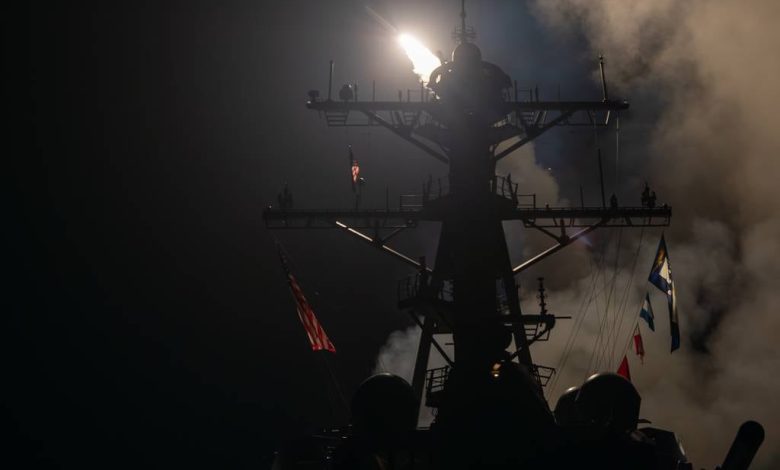Four lessons on sea denial from the Black and Red seas

In the early morning hours of Feb. 1, 2024, six Ukrainian sea drones destroyed the Russian missile ship Ivanovets in the Black Sea. The day prior, 2,000 miles away in the Red Sea, the U.S. Navy destroyer Carney successfully shot down three Iranian drones and an anti-ship ballistic missile fired by Houthi forces.
Two events, disparate in geopolitical context, present evidence that land-based maritime forces play a decisive role in naval operations. It does not take an act of imagination to see how U.S. Marines, the world’s foremost land-based maritime force, operating with a suite of high-end anti-ship weapons and uncrewed systems, would prove instrumental in a sea-denial campaign.
Since the dawn of the gunpowder age, land-based forces along coastal areas have challenged navies in their quest to dominate coastal seas. But in the last two decades, long-range precision weapons have proliferated among state and nonstate actors due to their plummeting costs. This development continues to favor terrestrial forces and has given new life to the sage wisdom of the 18th century naval strategist and tactician Adm. Horatio Nelson, who said: “A ship’s a fool to fight a fort.”
Using small, distributed littoral forces; civilian and military sensors; sea and airborne drones; long-range missiles; and an aircraft on one occasion, Ukraine has severely damaged or destroyed 24 Russian warships, including a submarine. Without any naval ships of its own, and relying exclusively on landward littoral forces, Ukraine has eliminated more than a third of Russia’s naval tonnage in the Black Sea, imposed costs into the billions of dollars, broken Moscow’s naval blockade of Odesa and other coastal cities, and created a badly needed maritime lifeline for merchant shipping.
In the Red Sea, we see a seemingly different picture. Yemen’s Iran-backed Houthis, operating under the pretext of solidarity with Palestinians in Gaza, are disrupting the free flow of global trade by attacking both commercial and naval vessels in the Red Sea. Like Ukrainian forces, they rely on drones and long-range missiles; but unlike Ukraine, they have sunk few ships.
There are lessons here, which may prove critical to future policy and resourcing considerations.
First, and most obviously, relative strength matters. The disparity between coalition and Houthi capabilities in the Red Sea is far wider than between Ukraine and Russian naval power in the Black Sea. Ukraine’s forces are well equipped, supported by NATO intelligence and technology, and confront an opponent of modest naval strength.
Houthi forces, by contrast, lack comparable support and face the world’s premiere naval force — a U.S. carrier strike group with a half dozen U.S. and coalition destroyers and frigates.
Second, counting the number of ships sunk is a shallow measurement of success. Using this metric, Ukraine’s scorecard is clear. But any objective assessment will also reveal that the Houthi’s sea-denial campaign has altered global trade routes, imposed global economic costs, enhanced its international profile, and perhaps most importantly tied up a significant portion of American naval power at a time when demand for our naval ships outstrips supply.
Third, fighting land forces with naval forces is costly. Fortunately for U.S. and coalition forces, the cost has been only monetary.
Since November 2023, the U.S. Navy has conducted more than 450 strikes, intercepting more than 200 drones and missiles. Naval forces are capable of countering enemy weapons with a range of capabilities, yet most far exceed the cost of the munition they are intended to destroy.
One-way Houthi attack drones have been estimated to cost as little as $2,000 to produce. Any defensive weapon that costs a dollar more puts us on the wrong side of the cost curve — and some counter-air missiles cost millions of dollars.
In the Red Sea, the costs have been acceptable to date, but we are in a new age of drone warfare, and production has skyrocketed. Ukraine and Russia, for example, each aim to acquire more than 2 million drones in 2024. A land-based force that employs drones at scale against one at sea will quickly deplete the latter’s defensive magazine — and that nation’s budget.
Finally, these maritime conflicts demonstrate that ground forces, difficult to locate and destroy, have a stubborn way of persisting. In the Black Sea, Russia has not employed its maritime firepower decisively against Ukraine’s anti-ship forces. In fact, it has retrenched almost entirely, choosing to relocate its fleet away from the threat.
By contrast, U.S. and coalition naval forces in the Red Sea have taken the fight to the Houthis, conducting dozens of strikes, destroying their missiles, drones and delivery systems. And yet, even in this lopsided contest, Houthi forces continue their disruption.
As we continue to observe Ukraine’s success in the Black Sea and the ongoing fight in the Red Sea, it will be important to temper our enthusiasm with a dose of humility. Winning and losing are fluid characterizations in combat, yet learning should be a constant.
Gen. Christopher Mahoney is the assistant commandant of the U.S. Marine Corps.







